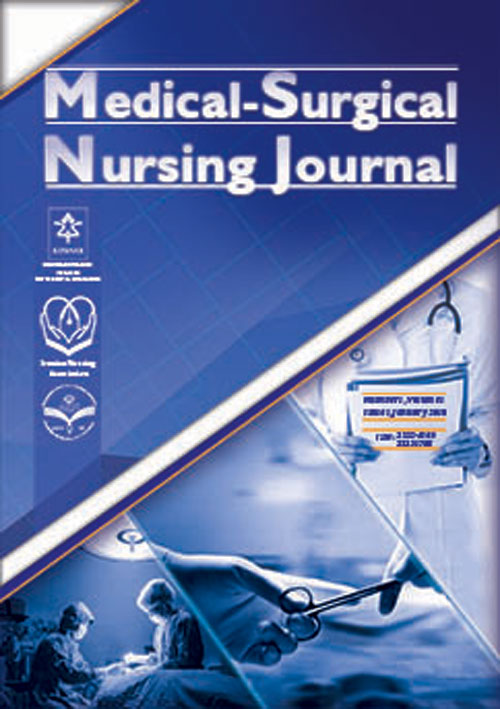فهرست مطالب

Iranian Journal Of Medical - Surgical Nursing
Volume:7 Issue: 4, Nov 2018
- تاریخ انتشار: 1397/08/15
- تعداد عناوین: 7
-
-
Page 1BackgroundHow health care providers perceive their capabilities affects their performance of their educational duties.ObjectivesThe present study was conducted on health and treatment staff to explain the experiences of health care providers regarding their perceived capabilities in delivering health education.MethodsThe present study is a qualitative study with a conventional content analysis approach, which was conducted in different environments, including hospitals, doctors’ offices, and health centers in Isfahan, Iran, using purposive sampling in 2017 - 2018. Thirty-two participants with an average experience of 8 years of work in health centers took part in this study. The data were analyzed using the MAXQDA software simultaneously with data collection.ResultsTwo themes emerged: (1) the ability to gain the audience’s trust, with the two main categories of personal characteristics and communication skills, and (2) professional capabilities with the two main categories of attitude to the profession and professional conversance. Some subcategories of both themes acted as both augmenting and diminishing factors affecting the perceived capabilities of the health care providers.ConclusionsAn individual has about his own personal characteristics, communication skills, and professional capabilities, which play central roles in the formation of their self-concepts. By enhancing these two factors via interventions based on the findings of such qualitative studies, the health care providers’ self-concept related to health education can be improved.Keywords: Health Care Providers, Health Education, Qualitative Study, Capabilities
-
Page 2BackgroundThe diagnostic and therapeutic uses of lead aVR in coronary artery disease, especially LAD stenosis, are very important in evidence-based nursing.ObjectivesThe aim of this study was to evaluate the knowledge and performance of nurses in applying lead aVR.MethodsIn this descriptive cross-sectional study, 88 nurses working in critical care units were enrolled. The data collection tool was a researcher-made questionnaire, which assessed the knowledge and performance of nurses. The data were analyzed in SPSS software (version 16) using t-test, Kruskal-Wallis test, Mann-Whitney test, and correlation coefficient test.ResultsThe mean score of nurses’ knowledge was 19.6 ± 5.1 (out of 60) and the majority (53.4%) had an undesirable knowledge level. The mean score of nurses’ performance was 17.3 ± 1.1 (out of 60) and the majority (67%) had an undesirable performance. Moreover, the performance score raised as work experience increased (P = 0.01; r = 0.6).ConclusionsGiven the inappropriate knowledge and performance levels of nurses concerning lead aVR application, it is recommended to modify the educational content and implement new educational methods in order to increase the knowledge and performance of nurses in this regard.Keywords: Nurses’ Knowledge, Nurses’ Performance, Lead aVR, ECG
-
Page 3BackgroundBreast cancer is one of the most common health problems and the most important cause to threaten women’s lives; however, its complications can be prevented by a timely diagnosis and effective therapeutic measures.ObjectivesThe aim of the present study was to determine the effect of motivational interviewing (MI)-based training, as compared with conventional training, on the frequency of breast cancer screening tests in female teachers in Zahedan during the year 2017.MethodsThis is a quasi-experimental study with a pretest-posttest design, which was carried out on 140 female teachers teaching in different levels of study in Zahedan, Iran, during the year 2017. Schools were selected randomly from two education districts using a multistage sampling method. The participants were divided into an intervention group receiving MI-based training (N = 70) and a conventional training group (N = 70). Training was provided to the MI-based training and conventional training groups based on the specified content during three sessions. Data collection was carried out using a demographic questionnaire and a screening test record form 20 weeks after the training. The frequency of breast self-examination, breast clinical examination, and mammography was evaluated. Data analysis was then conducted using the chi-square test, independent t-test, and paired t-test in SPSS version 21.ResultsAfter 20 weeks of training, breast self-examination was regularly practiced by 58.2% and 40.3% of women in the MI-based and conventional training groups, respectively (P = 0.02). The clinical breast exam (CBE) was carried out by 25.4% and 14.9% of women in the MI-based and conventional training groups, respectively (P = 0.09). Mammography was also done only by 10.4% and 4.5% of women in the MI-based and conventional training groups (P = 0.16).ConclusionsMI-based training increased women’s adherence to breast self-examination. Considering the positive effect of this approach on increasing the adherence to some breast cancer-screening behaviors, it is recommended to determine the effectiveness of this training method in other groups of women to increase the generalizability of the results.Keywords: Training, Women, Breast Cancer, Screening, Motivational Interviewing
-
Page 4BackgroundThalassemia is one of the most prevalent genetic disorders with numerous physical and psychological side effects. Spiritual wellbeing and spiritual coping are important resources for dealing with the complications of chronic diseases.ObjectivesThe present study aimed at investigating the relationship between spiritual coping and spiritual wellbeing in patients with beta-thalassemia major in Zahedan in 2016.MethodsThis descriptive-correlational study was conducted on 150 β-thalassemia major patients who referred to the Special Diseases Clinic of Ali Asghar Hospital of Zahedan in 2016. A convenience sampling was employed, and data collection tools included a clinical and demographic questionnaire and the Spiritual Coping and Wellbeing Questionnaire. The data were then analyzed by SPSS21 using statistical tests including Pearson’s correlation coefficient, independent t test, and one-way variance analysis.ResultsThere was a positive significant relationship between the mean score of spiritual wellbeing (81.05 ± 30.79) and the mean score of spiritual coping (40.47 ± 11.81) in β-thalassemia major patients (P = 0.001).ConclusionsThe improvement of spiritual coping entails boosting spiritual wellbeing. Given the positive impact of spiritual wellbeing on coping with symptoms in patients with chronic diseases, it is possible to promote the quality of life of these patients by enhancing their spiritual coping.Keywords: Spiritual Wellbeing, Spiritual Coping, Thalassemia
-
Page 5BackgroundThe life satisfaction of hemodialysis patients is correlated with their adherence to medical regimens and favorable health outcomes. Non-compliance is prevalent among these patients, and traditional training programs have not been adequate in achieving desirable results.ObjectivesThis study aimed at determining the effectiveness of a new self-care program, based on Orem’s model, in life satisfaction of hemodialysis patients.MethodsThis clinical trial was conducted in 59 patients. The subjects were undergoing hemodialysis and had referred to the Zabol Special Diseases Center (2017 - 2018). After the subjects were chosen via convenience sampling and their qualification was ensured, they were randomly assigned to either an intervention group or a control group. Data were gathered by means of a demographic questionnaire, a researcher-made inventory on self-care behaviors of hemodialysis patients based on Orem’s model (meant to identify self-care needs), and Diener’s satisfaction with life scale (SWLS). The questionnaires were filled out before and after the intervention. SPSS 22 was used to analyze the collected data. The statistical tests included independent t-test, paired t-test, Mann-Whitney U test, Fisher’s exact test, and chi-square test.ResultsAccording to the independent t-test, there was no significant difference in the mean score of life satisfaction between the two groups before the intervention. However, after the intervention, the mean score of life satisfaction in the intervention group increased significantly from 16.12 to 41.18. This change was determined based on Cohen’s kappa coefficient of 25.2 (P < 0.001).ConclusionsThe Orem-based self-care program could be effective in improving the life satisfaction of hemodialysis patients by enhancing self-care capacity, encouraging medical compliance, and reducing the dependency of these individuals. This program, being developed based on educational needs and the requirements of scientific methods, is proposed as a nursing intervention among these patients.Keywords: Self-Care Program, Orem’s Model, Hemodialysis Patients, Life Satisfaction
-
Page 6BackgroundPainful memories from previous childbirth can linger and impose negative effects on the mind of a woman throughout her life. They may also create a permanent fear of delivery and turn into a barrier to future pregnancies.ObjectivesThe aim of this study was to investigate the impact of mindfulness-based stress reduction (MBSR) on the fear of delivery in single-child mothers with a history of vaginal delivery in the city of Kerman, Iran.MethodsThis is an experimental, interventional study with pretest-posttest design and a control group. The statistical population encompassed all single-child women in the city of Kerman who had had childbirth at least six years earlier and had not become pregnant due to childbirth fear. The sample consisted of 41 participants, 20 of whom received the MBSR group training in eight sessions (each lasting for 90 minutes). Fear of childbirth was evaluated before and after the intervention using Harman's Childbirth Attitudes Questionnaire (CAQ). Data were analyzed by SPSS 22 using a paired t test, covariance, independent t test, and chi-square test.ResultsThe mean scores of childbirth fear in the intervention and control groups were 37.58 ± 5.9 and 33.19 ± 6.55, respectively, before implementing the program and 36.25 ± 5.40 and 33.00 ± 6.47 after that. The level of fear after the intervention was significantly higher in the experimental group than in the control group (P < 0.001). Besides, the greatest effects of the instructions were observed on the fear of painful injections, loneliness, and worry over the hospital environment.ConclusionsGroup training of MBSR is helpful in reducing childbirth fear, and thus it can be deployed as a procedure for encouraging childbearing in women who are not willing to re-experience pregnancy due to the fear of delivery.Keywords: Childbirth Fear, Mindfulness-Based Stress Reduction, Childbearing
-
Page 7BackgroundPain management programs in the case of patients with loss of consciousness could be advantageous inasmuch as they reduce the use of sedatives, prevent long hospitalization, and diminish the cost of treatment, medications, and hospitalization.ObjectivesThe present study aims to evaluate the effect of pain management algorithm on pain intensity in patients with loss of consciousness who had been hospitalized in an intensive care unit (ICU) in 2017.MethodsIn this randomized single-blind clinical trial, 90 patients with loss of consciousness who were under mechanical ventilation and admitted to the ICU of Khatam al-Anbiya Hospital, Zahedan were chosen through convenience sampling. Using permuted block randomization, the subjects were then assigned into intervention and control groups. Pain management algorithm was implemented in the intervention group for 24 hours during the morning shift between 8 a.m. and 10 a.m., during the evening shift between 3 p.m. and 5 p.m., and during the night shift between 10 p.m. and midnight. On the other hand, participants in the control group only received the routine care provided in the ward. Pain intensity was measured and recorded in both groups before and after the intervention. The tools used in this study included a demographic information form and the Behavioral Pain Scale (BPS). The data were analyzed in SPSS 15 using descriptive statistics, paired and independent t-tests, and chi-square.ResultsThere was no significant difference between the two groups in terms of gender, age, marital status, and the infused medications. The mean value of pain intensity in patients of the intervention group decreased after receiving the intervention for three shifts, and a significant difference was detected in the mean of this value before and after implementing the intervention. Conversely, the difference of the same variable in the control group was not significant before and after the intervention. In addition, the two groups significantly differed with regard to the mean changes of pain intensity during each of the three shifts (P < 0.001).ConclusionsImplementation of the pain management algorithm can significantly improve pain management in patients with loss of consciousness.Keywords: Pain Management Algorithm, Pain Intensity, Intensive Care Unit, Loss of Consciousness


